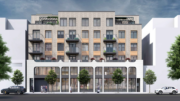Exterior work is progressing on 380 4th Avenue, a 17-story residential building in Gowanus, Brooklyn. Designed by GF55 Architects and developed by Quinlan Development Group LLC, the 175-foot-tall structure will span 211,650 square feet and yield 197 rental units with an average scope of 830 square feet, as well as 6,030 square feet of ground-floor commercial space, a cellar level, a 40-foot-long rear yard, and 30 enclosed parking spaces. Fifty of the units will be designated as affordable housing. The $78 million project is located between 3rd and 6th Streets.
The entire reinforced concrete superstructure was built since our last update in late September, when excavation and piling work were taking place on the large rectangular parcel and foundations had yet to commence. Recent photographs show the structure built to its parapet and installation of the brick façade progressing behind scaffolding and black netting. The grid of floor-to-ceiling windows currently covers the bottom third of the main southern elevation, and the northern and southern lot line walls are finished with tan EIFS paneling across their mostly blank surfaces. The hoist is attached to the main southern elevation facing 4th Avenue.
The renderings show the lower levels clad with light gray brick and the upper stories above the setback enclosed in bronze-hued metal paneling. The first two floors feature wide arched openings for the retail frontage and the main entrance, which is topped with a matching canopy with rounded corners. Setbacks on the 12th and 15th floors will be topped with outdoor terraces, and two small stacks of balconies are located on the upper half of the slender southwestern and northeastern elevations.
Residential amenities will include a rooftop terrace and an 11,000-square-foot parking garage, in addition to additional amenities to be announced later. The closest subways from the site are the F, G, and R trains at the 4th Avenue-9th Street station to the south.
380 4th Avenue’s anticipated completion date is slated for the summer of 2025, as noted on site.
Subscribe to YIMBY’s daily e-mail
Follow YIMBYgram for real-time photo updates
Like YIMBY on Facebook
Follow YIMBY’s Twitter for the latest in YIMBYnews
















Waiting for Arnelo, formally known as Guesser/guessers to spam the comment section with his copied text as usual here. Like clockwork…
The guy is obsessed. Lol
I’m surprised New York Yimby hasn’t pressed charges for online harassment against Guesser after all these years. They have every right to do so, or report to the DOJ, and could maybe see it as a second degree offense.
Either way, the guy’s a fucking scumbag
you asked for it and you got it.
The Gowanus Neighborhood Has Been Rezoned
In 2021, 82 blocks in Gowanus were changed from mainly industrial use to allowing residential development. The existing industrial buildings being demolished in the neighborhood will soon be replaced by dozens of apartment towers reaching up to 30 stories tall.
Most of the Rezoned Land is Highly Toxic
The vast majority of development sites in Gowanus (see map, below) are filled with cancer-causing toxins due to a century of industrial use, and have been classified by NY State as “Brownfield sites.” Some have toxins as deep as 150 feet.
The Infrastructure
Sewage Frequently Flows Into the Canal
During heavy rains, raw sewage flows into the canal because it exceeds the current sewer system’s capacity. As a result, the EPA has demanded that the City build two enormous “retention” tanks to keep excess sewage from going into the canal.
What’s The Problem?
The Land is Not Being Cleaned Up Fully, Leaving Toxins in the Soil
All of these sites need to be cleaned up before residential buildings can be built. State law requires they be cleaned to “pre-disposal conditions”—as they were before industrial poisoning. However, this is NOT happening. For instance, at some sites, where toxins reach as deep as 150 feet, the State is only calling for developers to clean less than the top 8 feet of contaminated soil.
Toxins Left in the Soil Can Enter Buildings And Threaten Future Residents’ Health
The State itself acknowledges that when certain toxins (“volatile organic compounds” or VOCs) are left in the soil, they can “move into buildings and affect the indoor air quality.”
Rather than remove them entirely, the State has decided that on the development sites, these toxins will be covered, or “capped,” with a slab of concrete. This method of dealing with toxic land, known as creating a “vapor intrusion barrier,” is very risky, and is so unreliable that these sites must be monitored every year, in perpetuity, to ensure that dangerous vapors haven’t penetrated people’s residences.
Arnelo/Guesser/guessers, it’s so amusing yet sad to see how easily triggered you are by showing how little self control you have, and never get a serious conversation out of anyone if you can’t find something else to write that’s not your own work.
glad you’re amused Sam, I aim to please
Have a great day
You act like a smartass, yet when push comes to shove, you’re left being the cold, shallow and cruel man you are…
What do you have against this website that makes you act like such an asshole?
50 so called affordable housing, when you hear affordable it really means another form of market rate units/rent in a shoe box apartments
The structure may not be designated as affordable housing, on the highest position that is starting to take its shape: Thanks.